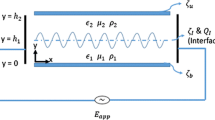Abstract
The endeavour to effectively harness interfacial electrohydrodynamic instabilities, to create small patterns, involves reducing the wavelength of the instability. This can be accomplished by decreasing the separation between the electrodes which may not always be possible. One may therefore have to reduce the surface tension or increase the applied voltage at a fixed electrode spacing. This can result in the wavelength of the pattern becoming of the same order as the electrode separation. Pease and Russel (J. Chem. Phys. 118, 3790 (2003)) were the first to argue that the commonly used Thin-Film Approximation (TFA) that involves an asymptotic expansion in the small parameter δ = (ε 0 φ 20 /(γh 0))1/2 (where ε 0 is the permittivity of vacuum, φ 0 is the root mean square value of the applied potential, γ is the surface tension and h 0 is the thickness of the thin film) need not always be valid and γ may not be small in experiments. Higher-order corrections to the TFA might therefore be necessary. We extend the Direct Current (DC) field analysis of Pease and Russel to an Alternating Current (AC) field. AC field has been suggested as an effective way of controlling the wavelength of electrohydrodynamic instabilities at fluid-fluid interfaces. Infact, the perfect and leaky dielectric limits can be realised in the same fluid at very high and very low electric field frequencies, respectively. Recently, Roberts and Kumar (J. Fluid Mech. 631, 255 (2009)) carried out an analysis using TFA to investigate AC-field-induced instabilities at air-polymer interfaces. We propose a Generalized Model (GM), without the lubrication approximation, and carry out detailed comparison with the TFA. We consider the top fluid to be air, a perfect dielectric, and the bottom fluid to be a perfect or a leaky dielectric. The analysis is carried out for both DC and AC fields, and the deviation from TFA is expressed in terms of the parameter B = γh 0/(ε 0 φ 20 ) = δ − 2. We discuss variation of the wavelength of the fastest growing mode with frequency of the applied field for any arbitrary value of B, unlike the analysis of Roberts and Kumar which is restricted to B ≫ 1(δ ≪ 1) . We also revisit the analysis of Pease and Russel for instabilities under DC field and present the results in terms of the single parameter, B.
Similar content being viewed by others
References
Yoav Tsori, Rev. Mod. Phys. 81, 1471 (2009).
Ning Wu, William B. Russel, NanoToday 4, 180 (2009).
P. Gambhire, R.M. Thaokar, Phys. Fluids 22, 064103 (2010).
S.A. Roberts, Satish Kumar, J. Fluid Mech. 631, 255 (2009).
J.M. Reynolds, Phys. Fluids 8, 161 (1965).
E.B. Devitt, J.R. Melcher, Phys. Fluids 8, 1193 (1965).
H. Terasawa, Y.H. Mori, K. Komotori, Chem. Engin. Sci. 38, 567 (1983).
James R. Melcher, Charles V. Smith, Phys. Fluids 12, 778 (1969).
Erik Schaffer, Thomas Thurn-Albrecht, Thomas P. Russell, Ullrich Steiner, Nature 403, 874 (2000).
Zhiqun Lin, Tobias Kerle, Shenda M. Baker, David A. Hoagland, Erik Schaffer, Ullrich Steiner, Thomas P. Russell, J. Chem. Phys. 114, 2377 (2001).
Zhiqun Lin, Tobias Kerle, Thomas P. Russell, Erik Schaffer, Ullrich Steiner, Macromolecules 35, 3971 (2002).
Mihai D. Morariu, Zhiqun Lin, Thomas P. Russell, Ullrich Steiner, Nature 2, 48 (2002).
Nicoleta E. Voicu, Stephan Harkema, Ullrich Steiner, Adv. Funct. Mater. 16, 926 (2006).
N. Arun, Ashutosh Sharma, Partho S.G. Pattadar, Indrani Banerjee, Hemant M. Dixit, K.S. Narayan, Phys. Rev. Lett. 102, 254502 (2009).
D.A. Saville, Annu. Rev. Fluid Mech. 29, 27 (1997).
Leonard F. Pease, William B. Russel, J. Chem. Phys. 118, 3790 (2003).
Leonard F. Pease, William B. Russel, J. Non-Newton. Fluid Mech. 102, 233 (2002).
V. Shankar, Ashutosh Sharma, J. Colloid Interface Sci. 274, 294 (2004).
R.M. Thaokar, V. Kumaran, Phys. Fluids 17, 084104 (2004).
R.V. Craster, O.K. Matar, Phys. Fluids 17, 032104 (2005).
D. Merkt, A. Pototsky, M. Bestehorn, Phys. Fluids 17, 064104 (2005).
Ruhi Verma, Ashutosh Sharma, Kajari Kargupta, Jaita Bhaumik, Langmuir 21, 3710 (2005).
Ning Wu, Leonard F. Pease III, William B. Russel, Langmuir 21, 12290 (2005).
Ning Wu, William B. Russel, Appl. Phys. Lett. 86, 241912 (2005).
Michael R. King, Jr. David T. Leighton, Mark J. Mc Cready, Phys. Fluids 11, 833 (1999).
Author information
Authors and Affiliations
Corresponding author
Rights and permissions
About this article
Cite this article
Gambhire, P., Thaokar, R.M. Linear stability analysis of electrohydrodynamic instabilities at fluid interfaces in the “small feature” limit. Eur. Phys. J. E 34, 84 (2011). https://doi.org/10.1140/epje/i2011-11084-9
Received:
Revised:
Accepted:
Published:
DOI: https://doi.org/10.1140/epje/i2011-11084-9




